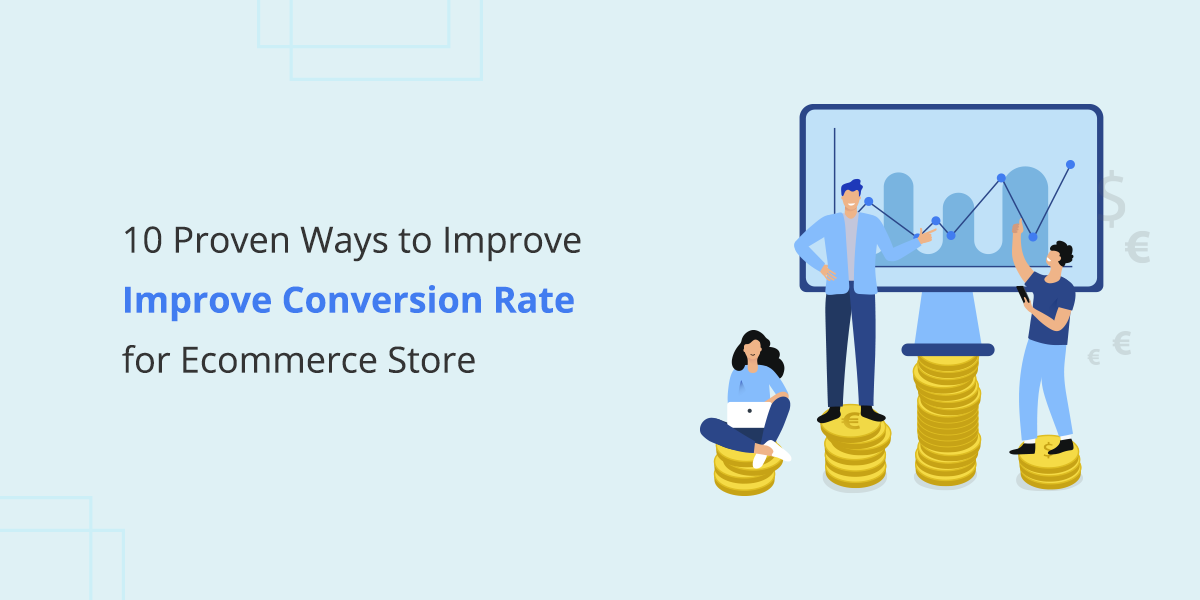Finding an answer to how to improve the conversion rate in ecommerce is mandatory when for the success of an online store. It is when you put all your in building an eCommerce website after choosing and sourcing products for it.
For any businessman, it is a matter of concern if the website attracts traffic but needs to convert it into customers. But it is ignored the most. According to a study shared by Rank Tracker, about 50% of the landing pages published will not be tested for improving conversions. If you face such an issue, conversion rate optimization can take you out of several valuable strategies.
To help deal with it, we share the top 10 proven ways of improving conversion for your eCommerce store in this post. Try any or all of the following ways as it applies to your store niche, scale and scope, and industry.
10 Ways to Improve Conversion Rate of Ecommerce Store
1. Understand Your Target Audience
It is common to know but difficult to follow. The first step towards improving the conversion rate of your eCommerce store is to see the target audience. Get to know about the people you aim to serve. Study their problems, issues, and preferences to understand how your products can help them.
Find customers’ preferences and pain points to address with specialized solutions or product personalization.
Understanding your target audience can lead you to create web copies and marketing messages better. For example, if you know customers are worried about the delivery charges, you can include it in the product cost and announce free shipping or similar offers. It will help you engage more customers
2. Optimize UX Design
The design and user experience of your eCommerce store matter the most when it comes to conversions. It includes adding features to improve navigation and product search. The more you provide ease in exploring difficult content sections of your online store, the better the design will be.
Users will easily find the products they need without spending a minute placing orders. The mobile-friendliness of your store is of great significance as you will need to find out the type and screen size a user is using while browsing your webshop. Things to consider reviewing:
- Simplify navigation
- Make it visually appealing
- Mobile-friendliness
- Page speed optimization
- Well-crafted web copies
- Clear category structure
Help your customers easily find what they are looking for. If you target people of a specific region, modify the website for local consumer behavior and everyday culture. Ecommerce website development in Pakistan may mold your online store with local trends and expectations. People who are new to online shopping may want a self-explanatory design. Find a reliable agency to make the necessary changes for you.
3. Turn on the advanced checkout process
The built-in checkout is often loaded with multiple steps that may turn the process slow and sluggish for an end user. It may include fields and options that no longer apply to your business or product. It is the reason; the checkout process or page needs to be improved with a modern layout and features. Review your existing checkout page and consider advancing it with the following techniques.
- Remove fields that are irrelevant to your store or products.
- Create additional fields with better user experience.
- Replace multiple pages with a one-page checkout.
- Implement on-page checkout to shorten the process.
- Add a checkout progress bar.
A difficulty in the checkout page leads to a higher cart abandonment rate. If you are getting leads but need help to make them finish a purchase, try the above methods to optimize the checkout for higher conversions. Your learning experience on improving your ecommerce conversion rate must also consider reducing the cart abandonment rate. It is better to prevent warm leads from leaving your stores because checkout could be smoother and quicker.
4. Remove compulsory registration
If you make it mandatory for the user to register before they place an order, you will lose many users who are careful about their privacy.
First, it is time-consuming, and they may never want to remember their login credentials. Secondly, they are protective about their personal and financial details and may not like the stores to retain them longer.
Allowing them to checkout as guest users will help them place orders with a few clicks and provide a sense of security. Make the user registration optional so that users may sign up voluntarily and not a compulsion.
5. Improve product images & description
Publish a product with high-quality images and a well-crafted description, and you will get all the answers on improving conversion rate in ecommerce. These are the essential components of a landing page. Craft a report highlighting all the features, benefits, and use cases to make it more engaging and educational for the end users. Answer the primary question of a user as to why they shall bypass all of your competitors and prefer your product or service.
Portray the unique selling point with the concept of fear of missing out. Let the customers or clients feel they will lose a lot if they leave or delay placing the order. Take help from visuals like high-resolution images, professional photo-shoot, or info-graphics to explain a process or procedure. Make sure the user gets a complete product overview despite the virtual sitting.
6. Project customer feedback
Making customers feel better about your products or services is half the play. If they leave them unattended, they may forget about your business. Ask them to share feedback to use it as social proof. Displaying customer reviews and testimonials on your product pages can significantly influence purchasing decisions.
Positive reviews and ratings serve as social proof. It reassures your potential buyers about the quality and reliability of your products. Encourage your customers to leave reviews, good or bad, to let them feel their opinion is valued. Show positive reviews as awards you have earned for exemplary customer satisfaction. Work on the negative reviews to remove quality or other concerns to make customers change their opinion about your brand or business.
7. Pursue more vigorous calls to action
An entire landing page is optimized to pursue visitors to take action. CTA or call to action is significant in taking leads towards maturity and converting them into customers. It usually includes words or phrases that invoke users to take an action. It may consist of Add to Cart, Buy Now, Add to Wish List, Subscribe, or Sign up.
The text of a call to action depends on the end goal webmaster wants to achieve. The store may focus more on sign-up buttons if it is about increasing the user base. Bloggers may be more interested in increasing newsletter subscribers. An eCommerce store may be looking for customers to boost revenues. Optimizing an online store for conversion may make you modify the calls to action.
Consider changing the following:
- Add power words such as Win, Get, Explore, Unleash, Activate, etc.
- Create urgency using words like the last three items left, offer expires in 10 minutes.
- Ask users, “Want to know more?”
- Represent users as “I was looking for it.”
- Try changing colors to settle with an appealing one.
- Change CTA positions, or add them to multiple places.
8. Implement live chat
Your store visitors may want to get a quick reply to a query they have in mind, but they may need more support to direct them to other stores.
An eCommerce store works like a conventional business, where a potential buyer may repeatedly want the same questions despite explaining them on the product and terms and conditions pages. They need to confirm it with a representative of yours in live chat.
Start with a bot-powered chat software or employ a few support workers to keep answering the visitors and converting them into customers.
9. Add social proofs
An eCommerce store must have fans and followers over social media channels like Facebook, Instagram, Twitter, and Pinterest. If you also possess a community, you can brag about it on the eCommerce store. It testifies that your store is reliable and trustworthy, as many users follow it. It will also increase social followers.
10. Pursue A/B testing
There are no set rules for conversion optimization regarding design elements and content. A layout, color, and font style that works for one website may or may not work for you. To make sure the optimization is helpful for you, pursue A/B testing. It works by testing two versions of the same design.
Check the effectiveness of each version and settle with the more productive one. For example, if one-page checkout is not brewing the anticipated results, switch back to multiple steps checkout process. Similarly, you can test both versions if you choose to implement live chat. First, try with the bot, and second, with human support. Review the result and finalize the best one.
Conclusion
Consider conversion optimization as a never-ending experience. The abovementioned ways are landmarks; the rest depends on your effort and creativity. Try any of them, innovate new ways, and let us know. We will share in this post if they are worthy to be mentioned.










